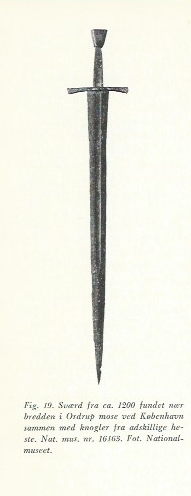http://myArmoury.com/feature_spotxvi.html
Chad Arnow shows some historic examples from England and Denmark of type XVI swords.
[ Linked Image ]
XVI.3 From the Nationalmuseet, Copenhagen
"Found in Denmark, this sword is in excellent condition. The edge erosion is likely caused by wear and honing rather than corrosion. There is a four-letter inscription found inlaid in the fuller. Like our previous examples, this piece dates from the first half of the 14th century."
This sword is from Ordrup Mose (North of Copenhagen), where it was found near the bog-shore along with numerous horse-bones from many horses!! [and apparently nothing else].
It was originally thought to be from ~1200 AD [Danish 1970 article], but apparently Oakeshott placed it from ~1300-1350 AD
Was someone doing a pagan sacrifice involving horses and sword in the ~1300 AD out at the bog - seriously old school??
The inscription on the blade is a 5-letter combination [not 4-letter] - NNDIG - according the article. No clue as to what it means, but likely a magical abbreviation.
Actually when I look at the close-up picture in the book I see 6 letters in another order along the blade. :wtf:
NI.........N.........D..........I........U? [picture just cuts the last letter, so could be the G I guess]. Well it seems the close-standing NI was somehow missed. Anyways it still doesn't make any sense.
So here is a scan from Nationalmuseets Arbejdsmark 1970. Rikke Behrend. “Vandfundne sværd fra middelalderen", page 100.
Sword inventory: Nationalmuseet nr. 16163.

Ordrup Mose Sword.
Source: Behrend (1970). Nationalmuseets Arbejdsmark 1970.

